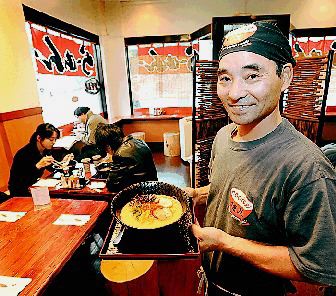Each sip of broth reveals different tinges of pork flavour
Mark Laba
Province

Shu Hara of Menya Japanese Noodle on West Broadway holds a bowl of Nagahama Ramen. Photograph by : Jason Payne, The Province
MENYA
Where: 401 W. Broadway, Vancouver
Payment/reservations: Major credit cards, 604-873-3277
Drinks: Soft drinks and beer
Hours: Mon.-Sat., lunch 11:30 a.m.-3 p.m., dinner, 5 p.m.-9 p.m., closed Sun.
– – –
You know that old expression “you can’t see the trees for the forest.” Well, this place decided to cut them all down to get rid of the problem entirely. Now you can see the trees but not the forest, or at least what’s left of the trees — essentially stumps turned into seats for die-hard ramen-noodle fans to plunk their broth-filled butts down on for this slurpable feast.
For generations of us Canadians raised on the Mr. Noodles variety of ramen with their strange silver packets of freeze-dried flavour ingredients that could either be green onion flakes or amazing Sea Monkeys, the true art of ramen noodle-making remains somewhat of a mystery.
For the Japanese it is an intricate dance between heaven and earth, or at least noodles and broth, with a cameo performance by seaweed and pork.
In our North American hunt for instant ramen gratification, we, in our noodle ignorance, have overlooked the subtler nuances of ramen broth, noodle texture and the mastery that this dark, burbling art demands.
Paid a visit with Small Fry Eli to this diminutive eatery where ravenous ramen gobblers were crammed to the rafters, the interior as sparse as a Zen monk’s mind. The stump seating beg the question, “if a tree falls in the forest but I’m in a ramen shop already sitting on its remains what came first, the noodle or the tree?” Or something like that.
Anyway, this newly opened spot is something of an anomaly on the Vancouver ramen scene due to its specialty in tonkotsu or pork-bone based broth. Most joints serve a mix of the other three ramen species — shio (salt), shoyu (soya) and miso — all of which use a chicken or vegetable or fish stock or a combination of the three.
Tonkotsu broth is cloudier in appearance and the flavour seems a little heavier than the other ramen varieties. I ordered the Nagahama Ramen ($6.75), named for a street full of ramen stalls in the Nagahama district of Fukuoka, the capital city of Kyushu Island where tonkotsu has its origins.
Doused with a special soya sauce seasoning I also ordered a seasoned boiled egg to be plunked into the mixture where pickled ginger, kelp, green onion and bamboo shoots bobbed about.
Hidden deep in the murk were two thick slices of slightly fatty pork belly to make the proceedings even porkier.
Each sip of broth revealed different tinges of flavours, as tenuous as a snowflake on the tongue, albeit a pork one.
A hint of ginger here, a blip of soya there and everywhere a rich, undercurrent of porker meat, probably due to the fat and marrow that seeps into the broth during the long and arduous boiling process.
Also tried the home-made pan-fried pork and vegetable gyoza ($4.80), eight of the suckers fused together into a pinwheel shape, crispy on the top side, soft as a frog’s belly underneath.
Very delicious and Small Fry Eli’s favorite dish, next to trying to scoop the ice out of his orange juice glass with a chopstick.
Essentially that’s the menu, with the tonkotsu ramen also available with a miso sauce seasoning or you can order the Ramen Noodle Set ($10) that gets you ramen, gyoza and Takikomi rice ball cooked with kelp, veggies and deep-fried tofu or try the Nagasaki Chanpon ($8.90), a ramen concoction with mixed veggies, meat and seafood. All I can say is landing in the soup never seemed so good.
THE BOTTOM LINE: A pork-a-rama of ramen goodness.
RATINGS: Food: B+; Service: B+; Atmosphere: B
© The Vancouver Province 2008

